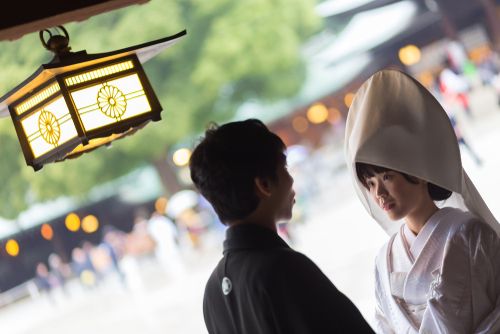 Shinto weddings, or Shinzen kekkon — “marriage before the kami” — are a relatively new invention, first taking place late in the 19th century among members of Shinto priests’ families. At the turn of the century, the wedding of Crown Prince Yoshihito, who became Emperor Taishō, and Princess Kujo Sadako made Shinto weddings popular and began the traditions of how weddings would be performed in a Shinto shrine, or jinja — place of the god or gods.
Shinto weddings, or Shinzen kekkon — “marriage before the kami” — are a relatively new invention, first taking place late in the 19th century among members of Shinto priests’ families. At the turn of the century, the wedding of Crown Prince Yoshihito, who became Emperor Taishō, and Princess Kujo Sadako made Shinto weddings popular and began the traditions of how weddings would be performed in a Shinto shrine, or jinja — place of the god or gods.
As of late, the incidence of Shinto weddings has been on the decline. A generation ago, 70% of Japanese people chose to be married in a Shinto ceremony. Today, that number has fallen to 20%, as many Japanese are choosing not to wed, and those that do are opting for Western-style weddings. When a Shinto wedding takes place, it’s usually only attended by family and close friends.
The Ceremony
The bride and groom are led into the shrine by shrine maidens, or Miko. The 20- to 30-minute ceremony begins with the ritual purification, where everyone stands and bows to be purified. Next is a prayer, where the priest announces the couple to be married to the altar, which is laden with sake, water, rice, fruits, vegetables, and salt, and to the kami — the spirits worshiped by followers of the Shinto faith.
After the prayer, the priest announces the san-san-ku-do — “three-three-nine-times” — where the bride and groom take three sips each from three different cups of sake. The origin and meaning of this core component of the ceremony is murky. Some people believe it’s related to the sharing of joys and sorrows of life. Others believe the three sips and three cups relate to man, woman, and child, or to heaven, earth, and mankind.
Next, the groom reads the wedding vows while the bride listens. The family drinks sake and salutes the bride and groom with the traditional cheer of “kampai.”
The last part of the ceremony involves offerings to the kami. The priest presents a branch of sakaki, a Japanese evergreen tree that’s sacred in the Shinto faith, to the altar. Then the bride and groom make their offerings to the altar. Finally, a representative of each family, typically the fathers of the bride and groom, makes offerings on behalf of the families.
What the Couple Wears
The bride and groom both wear kimonos. The bride’s consists of many layers, with the outer layer being the most ornate. She will either wear a brightly colored uchikake or pure white shiromuku as the outer layer; both are highly decorated.
The uchikake is usually made from heavy brocade fabric and embroidered with silver and gold thread. The shiromuku is embroidered with white thread in elaborate designs. Due to the high cost of these types of kimonos, brides may choose to rent them for the day, much like men rent tuxedos for Western weddings.
The bride also typically wears an elaborate wig, or katsura, and either a paper hat, or tsunokakushi — “horn hiding” — or large wataboshi — “cotton hood” — that hides her face from the wedding attendees, similar to the bridal veil in Western weddings. After the ceremony, the bride removes the headdress and may change into a red kimono for luck.
Post-War-Era Shinto Weddings
Before WWII, Shinto weddings were restricted to the elite. After the war, when Japan was stripped of State Shinto — where the government had co-opted Shinto as a patriotic practice rather than a religious one — Shinto weddings became more democratic. Anybody could be married in a Shinto religious ceremony. Nowadays, that includes Westerners who want a destination wedding.
Shinto weddings are simple but lovely. No longer the province of the elite, these ceremonies are available to anyone. With rituals that honor the kami, Shinto weddings are an auspicious start to a life of shared joys and sorrows with the person you love.